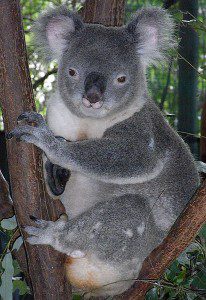

Blood or tissue samples were collected from koalas in different regions of Australia, and polymerase chain reaction (PCR) was used to detect the presence of KoRV proviral DNA, a DNA copy of the retroviral genome integrated into host cell DNA. Most of the koalas from the Australian mainland were positive for KoRV proviral DNA (442/466; 94.8%). All samples from animals in Queensland and New South Wales were KoRV positive. In mainland Victoria 65 of 89 animals contained KoRV DNA (73%). On the Victorian islands prevalence of KoRV ranged from 0% on Philip Island (0/11) to 50% on Snake Island (6/12). On the previously KoRV-free Kangaroo Island (link), 24 of 162 animals (14.8%) were KoRV positive. These results suggest that KoRV initially entered the koala population in the north of Australia and has been slowly spreading to the south. There are also other potential explanations for the results: there may be differences in KoRV susceptibility in northern versus southern animals, and the rate of transmission might differ in the two areas.
The genome of Queensland koalas contain far more copies of KoRV per cell, 165, than animals in Victoria, which ranged from less than one to 1.5 copies per cell. The Queensland koalas are likely fully endogenized – that is, the integrated KoRV DNA is passed from parent to offspring in the germline, and hence every koala cell contains viral DNA. In contrast, in Victoria koalas KoRV has either recently entered the germline (1.5 copies/cell) or has not yet entered this state (<1 copy/cell). In animals with less than one proviral copy per cell, KoRV infection was likely acquired exogenously from one animal to another. The mode of transmission of KoRV among koalas is not known, but might involve animal-animal contact or arthropod transmission.
It seems likely that eventually all wild koalas will be endogenized by KoRV. Whether this process will impact the long-term survival of the species is not known, especially since the disease caused by KoRV infection is poorly understood.
GS Simmons, PR Young, JJ Hanger, K Jones, D Clarke, JJ McKeed, J Meersa. 2012. Prevalence of koala retrovirus in geographically diverse populations in Australia. Austr. Vet. J. 90(10):404-9.
